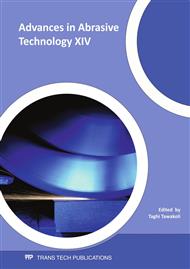p.495
p.502
p.508
p.517
p.523
p.530
p.536
p.542
p.548
Machining Characteristics of Magnetic Force-Assisted Electrolytic Machining for Polycrystalline Silicon
Abstract:
Wire electrical discharge machining (WEDM) of polycrystalline silicon (polysilicon) involves high-temperature melting that easily produces cracks on the silicon surface. This paper studies improvements of cracks and craters on surface of polysilicon after wire electrical discharge machining (WEDM) by magnetic force-assisted electrolytic machining (MFA-EM). The effects of different MFA-EM parameters on material removal and surface roughness are explored to understand the machining characteristics of MFA-EM and how magnetic field assistance contributes to high-efficiency and high-quality machining. Experimental results show that compared with standard EM, MFA-EM can achieve better machining efficiency and surface quality because MFA-EM can effectively enhance electrolyte circulation and replenishment, which contributes to better machining stability.
Info:
Periodical:
Pages:
523-529
Citation:
Online since:
August 2011
Authors:
Price:
Сopyright:
© 2011 Trans Tech Publications Ltd. All Rights Reserved
Share:
Citation:


